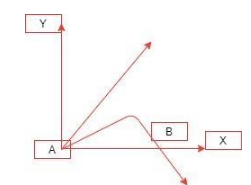
Answer
431.7k+ views
Hint: As the projectile is moving in downward direction. Therefore the component reverses its direction and its sign changes. The x-component remains the same.
Complete step by step solution
Consider that the projectile is fired from point A which is the initial point.
As the projectile moves, it covers distance along the horizontal due to the velocity of projection and along vertical in downwards direction due to the velocity attained under the effect of gravity.
Now, if we neglect friction due to air, then velocity of the projectile along horizontal will remain constant. So, the x component remains the same at point B, that is $ 2\hat{i} $ m/sec.
Now, when we talk about the motion along vertical, at point B the direction of y component changes and so the sign reverses, that is, it becomes $ -3\hat{j} $ m/sec.
So, the velocity at point B becomes $ \left( 2\hat{i}-3\hat{j} \right) $ m/sec.
So, the correct option is (C).
Note
Any object projected into space or air, such that it moves under the effect of gravity is called a projectile.
When projectile is fired parallel to horizontal, the equation of motion along horizontal is given as:
$ \begin{align}
& x=ut \\
& t=\dfrac{x}{u} \\
\end{align} $
Motion along vertical is given by:
$ \begin{align}
& y=\dfrac{1}{2}g{{t}^{2}} \\
& \text{ }=\dfrac{1}{2}g{{\left( \dfrac{x}{u} \right)}^{2}} \\
& y=\dfrac{g{{x}^{2}}}{2{{u}^{2}}} \\
\end{align} $
When projectile is fired at an angle to horizontal equation of motion along horizontal is
$ \begin{align}
& x=\left( u\cos \theta \right)t \\
& t=\dfrac{x}{u\cos \theta } \\
\end{align} $
Equation of motion along vertical is
$ y=\left( u\sin \theta \right)t+\dfrac{1}{2}g{{t}^{2}} $
When a projectile is thrown vertically upwards with velocity u, The time of flight of such a projectile is given by $ T=\dfrac{2\text{ }u\sin 90{}^\circ }{8}=\dfrac{2u}{8} $
When a projectile is at the highest point of its trajectory,
It possesses velocity only along horizontal.
The velocity and acceleration of the projectile are perpendicular to each other.
A projectile possesses same horizontal range, when it is projected at
Angle $ \theta $ with horizontal angle $ \theta $ with vertical.
Angle $ \theta $ or $ 90{}^\circ -\theta $ with horizontal.
Angle $ \left( 45{}^\circ +\theta \right) $ or $ \left( 45{}^\circ -\theta \right) $ with horizontal.
Complete step by step solution
Consider that the projectile is fired from point A which is the initial point.
As the projectile moves, it covers distance along the horizontal due to the velocity of projection and along vertical in downwards direction due to the velocity attained under the effect of gravity.
Now, if we neglect friction due to air, then velocity of the projectile along horizontal will remain constant. So, the x component remains the same at point B, that is $ 2\hat{i} $ m/sec.
Now, when we talk about the motion along vertical, at point B the direction of y component changes and so the sign reverses, that is, it becomes $ -3\hat{j} $ m/sec.
So, the velocity at point B becomes $ \left( 2\hat{i}-3\hat{j} \right) $ m/sec.
So, the correct option is (C).
Note
Any object projected into space or air, such that it moves under the effect of gravity is called a projectile.
When projectile is fired parallel to horizontal, the equation of motion along horizontal is given as:
$ \begin{align}
& x=ut \\
& t=\dfrac{x}{u} \\
\end{align} $
Motion along vertical is given by:
$ \begin{align}
& y=\dfrac{1}{2}g{{t}^{2}} \\
& \text{ }=\dfrac{1}{2}g{{\left( \dfrac{x}{u} \right)}^{2}} \\
& y=\dfrac{g{{x}^{2}}}{2{{u}^{2}}} \\
\end{align} $
When projectile is fired at an angle to horizontal equation of motion along horizontal is
$ \begin{align}
& x=\left( u\cos \theta \right)t \\
& t=\dfrac{x}{u\cos \theta } \\
\end{align} $
Equation of motion along vertical is
$ y=\left( u\sin \theta \right)t+\dfrac{1}{2}g{{t}^{2}} $
When a projectile is thrown vertically upwards with velocity u, The time of flight of such a projectile is given by $ T=\dfrac{2\text{ }u\sin 90{}^\circ }{8}=\dfrac{2u}{8} $
When a projectile is at the highest point of its trajectory,
It possesses velocity only along horizontal.
The velocity and acceleration of the projectile are perpendicular to each other.
A projectile possesses same horizontal range, when it is projected at
Angle $ \theta $ with horizontal angle $ \theta $ with vertical.
Angle $ \theta $ or $ 90{}^\circ -\theta $ with horizontal.
Angle $ \left( 45{}^\circ +\theta \right) $ or $ \left( 45{}^\circ -\theta \right) $ with horizontal.
Recently Updated Pages
Fill in the blanks with suitable prepositions Break class 10 english CBSE

Fill in the blanks with suitable articles Tribune is class 10 english CBSE

Rearrange the following words and phrases to form a class 10 english CBSE

Select the opposite of the given word Permit aGive class 10 english CBSE

Fill in the blank with the most appropriate option class 10 english CBSE

Some places have oneline notices Which option is a class 10 english CBSE

Trending doubts
Fill the blanks with the suitable prepositions 1 The class 9 english CBSE

How do you graph the function fx 4x class 9 maths CBSE

When was Karauli Praja Mandal established 11934 21936 class 10 social science CBSE

Which are the Top 10 Largest Countries of the World?

What is the definite integral of zero a constant b class 12 maths CBSE

Why is steel more elastic than rubber class 11 physics CBSE

Distinguish between the following Ferrous and nonferrous class 9 social science CBSE

The Equation xxx + 2 is Satisfied when x is Equal to Class 10 Maths

Differentiate between homogeneous and heterogeneous class 12 chemistry CBSE





